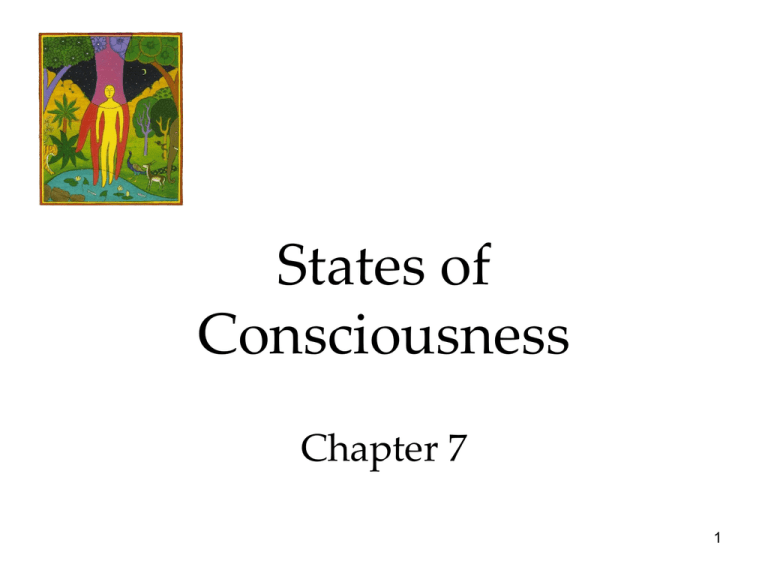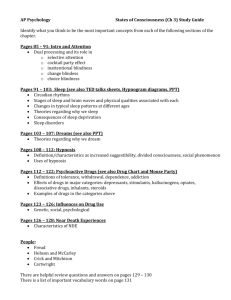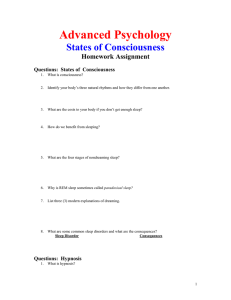
States of
Consciousness
Chapter 7
1
History of Consciousness
1. Psychology began as a science of
consciousness.
2. Behaviorists argued about alienating
consciousness from psychology.
3. However, after 1960, mental concepts
(consciousness) started reentering
psychology.
2
Forms of Consciousness
AP Photo/ Ricardo Mazalan
Stuart Franklin/ Magnum Photos
Christine Brune
Bill Ling/ Digital Vision/ Getty Images
Consciousness, modern psychologists believe, is
an awareness of ourselves and our environment.
3
Neuroscience & Consciousness
Neuroscientists believe that consciousness
emerges from the interaction of individual
brain events much like a chord that is created
from different musical notes.
4
Levels of Consciousness
5
Consciousness & Information
Processing
The unconscious mind processes information
simultaneously on multiple tracks, while the conscious
mind processes information sequentially.
Conscious mind
Unconscious mind
6
Sleep & Dreams
Sleep – the irresistible tempter to whom we
inevitably succumb.
Mysteries about sleep and dreams have just started
unraveling in sleep laboratories around the world.
7
Sleep
• Sleep is a state of
consciousness.
• We are less aware
of our surroundings.
• Circadian Rhythm
8
Biological Rhythms
Biological rhythms are controlled by
internal “biological clocks.”
1. Annual cycles: On an annual cycle, geese
migrate, grizzly bears hibernate, and humans
experience seasonal variations in appetite,
sleep, and mood. Seasonal Affective Disorder
(SAD) is a mood disorder people experience
during dark winter months.
9
Biological Rhythms
2. 28-day cycles: The
female menstrual
cycle averages 28
days. Research
shows menstruation
may not affect
moods.
10
Biological Rhythms
3. 24-hour cycles: Humans experience 24-hour
cycles of varying alertness (sleep), body
temperature, and growth hormone secretion.
4. 90-minute cycles: We go through various stages
of sleep in 90-minute cycles.
11
Rhythm of Sleep
Illustration © Cynthia Turner 2003
Circadian Rhythms occur on a 24-hour cycle and
include sleep and wakefulness, which are
disrupted during transcontinental flights.
Light triggers the suprachiasmatic nucleus to decrease
(morning) melatonin from the pineal gland
and increase (evening) it at night fall.
12
Sleep Stages
Measuring sleep: About every 90 minutes, we
pass through a cycle of five distinct sleep stages.
Hank Morgan/ Rainbow
13
Awake & Alert
During strong mental engagement, the brain
exhibits low amplitude and fast, irregular beta
waves (15-30 cps). An awake person involved in a
conversation shows beta activity.
Beta Waves
14
Sleep Cycle
• Use an EEG machine
to measure stages of
sleep.
• When you are the
onset of sleep you
experience alpha
waves.
• Produces mild
hallucinations, like a
feeling of falling.
15
Awake but Relaxed
When an individual closes his eyes but remains
awake, his brain activity slows down to a large
amplitude and slow, regular alpha waves (9-14
cps). A meditating person exhibits an alpha brain
activity.
16
Stages of Sleep
• Stage 1 – Non REM
Light Sleep. IF woken here
person probably not believe
they were sleeping
-hypnagogic images
-hypnic jerks
Stages of Sleep
• Stage 2 – Non REM
Sleep Spindles
Body temp continues to drop
heart rate slows, breathing
become shallow and irregular
Stages of Sleep
• Stage 3 & 4 – Non REM
Delta Waves!
Growth hormones released
hard to wake – children sleep
deeper
Stages of Sleep
• REM
– After reverting back through stages 3 and 2, the brain
enters the REM (rapid eye movement) stage
– Marked by more vivid, detailed, and storylike dreams
• We dream during all stages but these are more visual
• REM paralysis – voluntary muscles are paralyzed
• Each cycle lasts roughly 90 minutes
• Approx. 4 to 6 cycles per night
– The first time through the cycle, you only spend about
10 minutes in REM – which increases to 30 to 60
minutes by the last cycle
Sleep Patterns and Age
Stages of Sleep
• REM rebound - IF you are deprived of
REM sleep one night you’ll usually make it
up the next night
Sleep Disorders
• Nightmares
– Tend to happen more in children b/c spend
more time in REM sleep
• REM Behavior Disorder
– Rare… the brain mechanisms that normally
inhibit voluntary muscles…fails. Thrashing,
acting out nightmares
• Stage 4 Sleep Disorders (sleeping walking
or somnambulism)
Sleep Disorders
• Night Terrors
– Rare disorder – a state of panic while sound
asleep. Occurs during deep Non-REM sleep
• Insomnia
– the inability to get to sleep
• Sleep Apnea
– A condition where a person stops breathing
for 30 secs or more. Hard to get a good sleep
• Narcolepsy
– Disorder – sleep seizure. Person slips into
REM during the day
90-Minute Cycles During Sleep
With each 90-minute cycle, stage 4 sleep decreases
and the duration of REM sleep increases.
25
Why do we sleep?
We spend one-third of
our lives sleeping.
Jose Luis Pelaez, Inc./ Corbis
If an individual
remains awake for
several days, they
deteriorate in terms of
immune function,
concentration, and
accidents.
26
Sleep Deprivation
1. Fatigue and subsequent death.
2. Impaired concentration.
3. Emotional irritability.
4. Depressed immune system.
5. Greater vulnerability.
27
Peter Tripp
• Stayed awake for 201 hours to raise
money for March of Dimes
• Slept for 24 hours straight after the
experiment
• Severe psychological damage done
• Lost job and wife due to change in
behavior
• http://www.youtube.com/watch?v=nSNRdv
usmQs
28
Accidents
Frequency of accidents increase with loss of sleep
29
Sleep Theories
1. Sleep Protects: Sleeping in the darkness when
predators loomed about kept our ancestors out
of harm’s way.
2. Sleep Recuperates: Sleep helps restore and
repair brain tissue.
3. Sleep Helps Remembering: Sleep restores and
rebuilds our fading memories.
4. Sleep and Growth: During sleep, the pituitary
gland releases growth hormone. Older people
release less of this hormone and sleep less.
30
Sleep Disorders
31
Insomnia
• Persistent problems
falling asleep
• Inability to fall
asleep or stay asleep
32
Narcolepsy
• Suffer from
sleeplessness and
may fall asleep at
unpredictable or
inappropriate times.
• Directly into REM
sleep
• Dee Daud
– Suffers from
Narcolepsy
– http://www.youtube.
com/watch?v=Mya
onferplk
• Bo the Narcoleptic
Dog
– http://www.youtube.
com/watch?v=nvM
yuZKGKAY
33
Sleep Apnea
• A person stops
breathing during
their sleep.
• Wake up
momentarily, gasps
for air, then falls
back asleep.
• Very common,
especially in heavy
males.
• Can be fatal.
34
Night Terrors
• Wake up with from a
deep sleep.
• May feel panic
• May wake up
screaming and have
no idea why.
• Not a nightmare.
35
Somnambulism
• Sleep Walking
• Most often occurs
during the first few
hours of sleeping and
in stage 4 (deep
sleep).
• If you have had
night terrors, you
are more likely to
sleep walk when
older.
36
Sleep Disorders review
1. Somnambulism: Sleepwalking.
2. Nightmares: Frightening dreams that wake
a sleeper from REM.
3. Night terrors: Sudden arousal from sleep
with intense fear accompanied by
physiological reactions (e.g., rapid heart
rate, perspiration) that occur during SWS.
37
Sleep Disorders review
4. Narcolepsy: Overpowering urge to fall
asleep that may occur while talking or
standing up.
5. Sleep apnea: Failure to breathe when
asleep.
38
Dreams
39
Dreams
The link between REM
sleep and dreaming
has opened up a new
era of dream research.
40
Dreams
1. Negative Emotional Content: 8 out of 10
dreams have negative emotional content.
2. Failure Dreams: People commonly dream
about failure, being attacked, pursued,
rejected, or struck with misfortune.
3. Sexual Dreams: Contrary to our thinking,
sexual dreams are sparse. Sexual dreams in
men are 1 in 10; and in women 1 in 30.
4. Dreams of Gender: Women dream of men
and women equally; men dream more about
men than women.
41
Freud’s Theory of Dreams
• Dreams are a
roadway into our
unconscious.
• Manifest Content
(storyline)
• Latent Content
(underlying meaning)
42
Activation-Synthesis Theory
• Our Cerebral Cortex
is trying to interpret
random electrical
activity we have
while sleeping.
• That is why dreams
sometimes make no
sense.
• Biological Theory.
43
Information-Processing Theory
• Dreams are a way to
deal with the
stresses of everyday
life.
• We tend to dream
more when we are
more stressed.
44
Physiological Function
theory: Dreams
provide the sleeping
brain with periodic
stimulation to
develop and preserve
neural pathways.
Neural networks of
newborns are quickly
developing; therefore,
they need more sleep.
45
4. Cognitive Development theory: Some
researchers argue that we dream as a
part of brain maturation and cognitive
development.
All dream researchers believe we need REM sleep. When
deprived of REM sleep and then allowed to sleep,
we show increased REM sleep called REM Rebound.
46
Dream Theories
Summary
47
Hypnosis
http://iddiokrysto.blog.excite.it
A social interaction in
which one person (the
hypnotist) suggests to
another (the subject)
that certain
perceptions, feelings,
thoughts, or behaviors
will spontaneously
occur.
Hypnos: Greek god of sleep
48
Mesmerism
http://www.general-anaesthesia.com
Credit for the popularity
of hypnosis goes to
Franz Anton Mesmer, a
physician, who
mistakenly thought he
discovered “animal
magnetism.” Some of his
patients experienced a
trancelike state and felt
better upon waking up.
Franz Mesmer (1734 - 1815)
49
Aspects of Hypnosis
1. Posthypnotic Suggestion: Suggestion carried
out after the subject is no longer hypnotized.
2. Posthypnotic Amnesia: Supposed inability to
recall what one experienced during hypnosis.
50
Hypnosis
51
Hypnosis
• Altered state of
consciousness?
• Posthypnotic
suggestion
• Posthypnotic
amnesia
52
Hypnotic Feats
Strength, stamina, and perceptual and memory
abilities similarly affect those who are
hypnotized and those who are not
hypnotized.
53
Hypnosis theories
Courtesy of News and Publications Service, Stanford University
1. Social Influence Theory:
Hypnotic subjects may
simply be imaginative
actors playing a social
role.
2. Divided Consciousness
Theory: Hypnosis is a
special state of
dissociated (divided)
consciousness (Hilgard,
1986, 1992).
(Hilgard, 1992)
54
Hypnotic Theories
Social influence/Role
Theory
• Hypnosis is NOT an
altered state of
consciousness.
• Different people have
various state of hypnotic
suggestibility.
• A social phenomenon
where people want to
believe.
• Work better on people
with richer fantasy lives.
Divided consciousness/
State Theory
• Hypnosis is an altered
state of consciousness.
• Dramatic health
benefits
• It works for pain best.
55
Mimi Forsyth
Both Theories
56
Facts and Falsehood
Those who practice hypnosis agree that its power
resides in the subject’s openness to suggestion.
Can anyone experience hypnosis?
Yes, to some extent.
Can hypnosis enhance recall of
forgotten events?
No.
57
Facts and Falsehood
Can hypnosis force people to act
against their will?
No.
Can hypnosis be therapeutic?
Yes. Self-suggestion
can heal too.
Can hypnosis alleviate pain?
Yes. Lamaze can
do that too.
58
Dissociation Theory
• Theory by Ernest
Hilgard.
• We voluntarily divide
our consciousness up.
• Ice Water
Experiment.
• We have a hidden
observer, a level of
us that is always
aware.
59
Drugs
60
61
Drugs
• Our brain is
protected by a layer
of capillaries called
the blood-brain
barrier.
• The drugs that are
small enough to pass
through are called
psychoactive drugs.
62
Drugs and Consciousness
Psychoactive Drug: A chemical substance that
alters perceptions and mood (effects
consciousness).
63
Drugs are either….
• Agonists
• Antagonists
• Reuptake inhibitors
If a drug is used often,
a tolerance is created
for the drug.
Thus you need more of
the drug to feel the
same effect.
If you stop using a drug
you can develop
withdrawal symptoms.
64
Withdrawal & Dependence
1. Withdrawal: Upon stopping use of a drug
(after addiction), users may experience the
undesirable effects of withdrawal.
2. Dependence: Absence of a drug may lead to a
feeling of physical pain, intense cravings
(physical dependence), and negative emotions
(psychological dependence).
65
Misconceptions about Addiction
Addiction is a craving for a chemical substance,
despite its adverse consequences (physical &
psychological).
1. Addictive drugs quickly corrupt.
2. Addiction cannot be overcome voluntarily.
3. Addiction is no different than repetitive
pleasure-seeking behaviors.
66
Psychoactive Drugs
Psychoactive drugs are divided into three groups.
1. Depressants
2. Stimulants
3. Hallucinogens
67
Depressants
• Slows down body
processes.
• Alcohol
• Pain Killers
• Tranquilizers
68
Alcohol
1. Alcohol affects motor skills, judgment, and
memory…and increases aggressiveness while
reducing self awareness.
Ray Ng/ Time & Life Pictures/ Getty Images
Daniel Hommer, NIAAA, NIH, HHS
Drinking and Driving
69
Alcohol
• More than 86 billion
dollars are spent
annually on alcoholic
beverages.
• Alcohol is involved in
60% of ALL crimes.
• Alcohol is involved in
over 70% of sexually
related crimes.
• Is it worth the cost?
70
2. TRANQUAILZERS: Drugs that depress the
activity of the central nervous system,
reducing anxiety but impairing memory and
judgment. Nembutal, Seconal, Xanax, Valium
and Amytal are some examples.
71
http://opioids.com/timeline
3. Pain Killers/ Opiates:
Opium and its
derivatives (morphine
and heroin) depress
neural activity,
temporarily lessening
pain and anxiety. They
are highly addictive.
72
Pain Killers/Opiates
• Has depressive and
hallucinogenic qualities.
• Agonist for endorphins.
• Morphine, heroin,
methadone, codeine,
etc.
• All these drugs cross
the placental
barrier….teratogens.
73
Stimulants
• Speed up body
processes.
• More powerful ones
(like cocaine) give
people feelings of
invincibility.
74
Stimulants
Stimulants are drugs that excite neural activity and
speed up body functions.
1.
2.
3.
4.
Caffeine
Nicotine
Cocaine
Ecstasy (can also
act as a
hallucinogen)
5. Amphetamines
6. Methamphetamines
75
Caffeine & Nicotine
Caffeine and nicotine increase heart and
breathing rates and other autonomic functions to
provide energy.
http://office.microsoft.com/clipart
http://www.tech-res-intl.com
76
Amphetamines
Amphetamines stimulate neural activity, causing
accelerated body functions and associated energy
and mood changes, with devastating effects.
National Pictures/ Topham/ The Image Works
77
Ecstasy
Greg Smith/ AP Photos
Ecstasy or
Methylenedioxymethamphet
amine (MDMA) is a
stimulant and mild
hallucinogen. It produces a
euphoric high and can
damage serotonin-producing
neurons, which results in a
permanent deflation of mood
and impairment of memory.
78
Cocaine
Cocaine induces immediate euphoria followed by a crash.
Crack, a form of cocaine, can be smoked. Other forms of
cocaine can be sniffed or injected.
http://www.ohsinc.com
79
Hallucinogens
• Psychedelics
• Causes changes in
perceptions of
reality
• LSD, peyote,
psilocybin
mushrooms and
marijuana, etc.
• Reverse tolerance or
synergistic effect
80
Hallucinogens
Ronald K. Siegel
Hallucinogens are
psychedelic (mindmanifesting) drugs that
distort perceptions and
evoke sensory images in
the absence of sensory
input.
81
Hallucinogens
Hemp Plant
http://static.howstuffworks.com
1. LSD: (lysergic acid diethylamide) powerful
hallucinogenic drug (ergot fungus) that is
also known as acid.
2. THC (delta-9-tetrahydrocannabinol): is the
major active ingredient in marijuana (hemp
plant) that triggers a variety of effects,
including mild hallucinations.
82
Drugs
Summary
83
Influences on Drug Use
The graph below shows the percentage of US highschool seniors reporting their use of alcohol,
marijuana, and cocaine from the 70s to the late 90s.
84
Influences on Drug Use
The use of drugs is based on biological,
psychological, and social-cultural influences.
85
Marijuana Use
The use of marijuana in teenagers is directly related
to the “perceived risk” involved with the drug.
86
Near-Death Experiences
(From “Hallucinations” by R.K. Siegel. Copyright
© 1977 Scientific American, Inc. All rights reserved.)
After a close brush with
death, many people
report an experience of
moving through a dark
tunnel with a light at the
end. Under the influence
of hallucinogens, others
report bright lights at
the center of their field
of vision.
87
Mind-Body Problem
Near-death experiences raise the mind-body issue.
Can the mind survive the dying body?
1. Dualism: Dualists believe that mind (nonphysical) and body (physical) are two distinct
entities that interact.
2. Monism: Monists believe that mind and body
are different aspects of the same thing.
88




